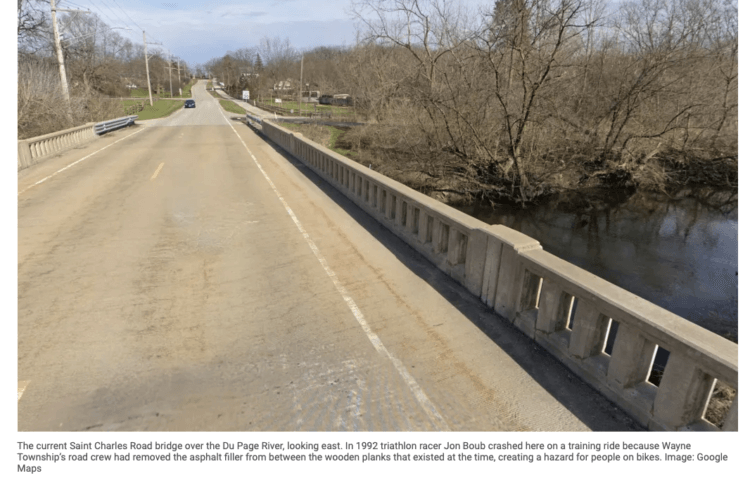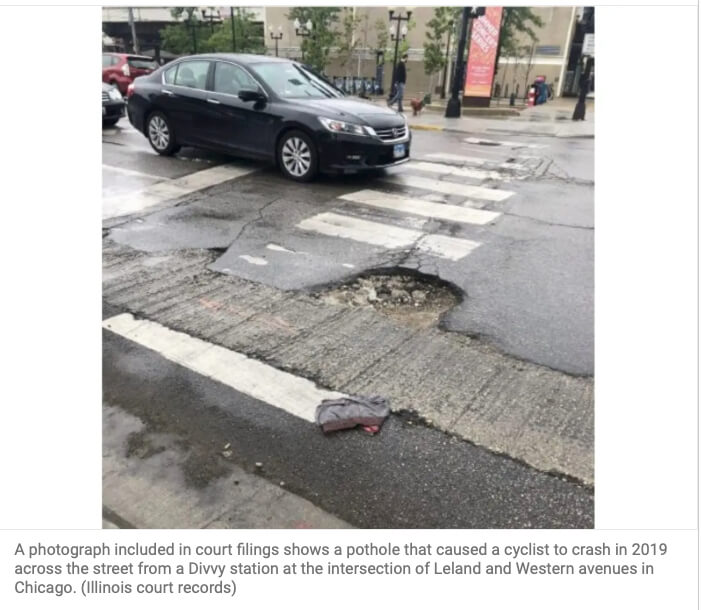Last week a case came out of Illinois that has bicycle legal folks, the 3 or 4 of us out there, talking a lot. To understand THAT case you have to understand a bit about another IL case from a few DECADES ago…
Back in the late 1990s there was an Illinois case that had a VERY bad result for IL cyclists – Boub v. Township of Wayne, released 10/22/1998. Mr. Boub was injured in 1992 while riding his bicycle in Wayne Township, IL. He was riding across a one lane bridge. The bridge surface consisted of wooden planks and the asphalt between the planks had been removed during a bridge renovation project.
You can predict what happened…
Boub’s bike hits the space, tires get stuck, and he goes head over handlebars, suffering injury. He sues Wayne Township for failing to keep the road/bridge in good repair.
Streetsblog Chicago recently reviewed the Boub case while discussing the new one and posted this shot of the bridge, now concrete, that took out Jon Boub while he was on a training ride:

Under the Illinois legal code the government is entitled to a certain level of immunity, as it is in Ohio. Boub made allegations under this statute, making a claim and seeking damages. He lost at the trial level as the case was kicked out on a pre-trial motion filed by the municipality.
He appealed, and lost. The appellate court held the municipality was immune.
The IL SupremeCourt agreed to hear the case and allowed The League of IL Bicyclists & the Chicagoland Bicycle Federation to file amicus curiae [friend of the court] briefs. I remember this well as I was involved with both the Ohio Bicycle Federation & the LAB at the time and had numerous conversations at the national level about the possible ramifications here.
IL law is a bit unique in that it says that a public entity must exercise ordinary care to maintain its property in a reasonably safe condition “…for uses that are BOTH permitted AND INTENDED…”
Boub had to show he was both a permitted user of the bridge and an INTENDED user of the road/bridge … this second part is where the hang up came in 1998, and it reared up again in the case released last week.
To try to figure out if a bicycle operator was an INTENDED user of the road/bridge the court looked at some PEDESTRIAN cases. Courts in IL had held, for example, that “crosswalks” put in place by a municipality could be evidence that the city INTENDED people to walk there. So if folks walked outside these designated pedestrian zones the city’s immunity would kick in b/c the pedestrians were not intended users of the roadway other than in the limited pedestrian-specific spaces.
The court felt that it could be “guided by” some of the same signs and pavement markings in trying to determine if a cyclist was an INTENDED user of a particular piece of infrastructure…when they looked at the signage around the bridge they found … nothing… nothing to indicate that bicyclists were an INTENDED user of the bridge…
The Court in Boub said:
“Just as the presence or absence of special pavement markings and signs is relevant in determining whether pedestrians are intended users of streets & highways, so too do we believe that the presence or absence of pavement markings and signs is relevant here in determining whether the plaintiff was an intended user of the road and bridge where the accident occurred. In the present case there is nothing in the roadway or bridge that would suggest it was intended for use by bicycles. No special pavement markings or signs indicated that bicyclists, like motorists, were intended to ride on the road or bridge… “
The court went through some very circuitous “logic” to find that cyclists were not intended users in Boub… IllinoisCyclists LOST in a major way that day. We were afraid that this type of argument/logic was take hold in other place, but so far it has not.
This was a 4-3 decision released in 1998, 6+ years after Mr. Boub got hurt.
The Dissent in Boub starts off… “I respectfully dissent from this absurd and dangerous proposition” and goes on to explain why they think the logic used by the 4 in the majority was ridiculous…
So now, flash forward to December, 2023. Last week the same Court applied the same “logic” to prevent an injured Chicago cyclist from suing the city over a “pothole” that caused a nasty crash.
This case involved a crash caused by a pothole in Chicago, not a wooden plank bridge in a small township…
The pothole:

In this case, as in Boub, the trial judge threw out the case on motions and that ruling was upheld.
Here, though, the appellate court REVERSED the trial court, holding that there was an “IMPLIED INTENT” expressed by the City that cyclists could use the roads since: a/ Bikes were NOT ALLOWED on sidewalks under Chicago’s city code, and b/ a “Divvy” station was placed at the point of the crash [Divvy = Bike share] and c/city knew people would not simply WALK their bikes if no bike lane was available…
This time the Supreme Court ruling was unanimous. The Illinois Supreme Court relied on the lack of signage and the argument that the roads in question were not “designated bike routes” and did not have any signs declaring that the city “intended” for people to use bicycles there….
You can read the 2023 opinion in Alave v. City of Chicago here –
You can read the 1998 Boub v. Wayne Township case here–
The 2023 llinois Supreme Court reinforced Boub, and held that the cyclist could not pursue the claim against the City over this pothole because the bicycle operator was NOT an “INTENDED” user of that roadway.
In Ohio, while there are SUBSTANTIAL hurdles to suing and winning against municipality over road defects, we do NOT have this issue. Our immunity law is not based on proving “intended” road users. There are still very significant immunity burdens to overcome to sue the city.
We have a case percolating now against against a municipality… A Cyclist was commuting to work in the pre-dawn hours. He took a road that wound through a park and connected to another road that took him to his job – the city had placed a swinging barricade along the road through the park so the road could be closed off for park events. However, the City had, based on our evidence, allowed the barricade to deteriorate to the point that it could be swung out over the road despite being “locked” open. As our client rode through in the dark [with appropriate lights] he ran into the gate, which had been swung out across/into his lane and suffered substantial injuries.
The City in our case argues that it is entitled to Immunity under a variety of statutes… along with some other defenses, including whether the “road” was even a public road that the City had to maintain and whether the park was “closed” which would make the rider a “trespasser” in their eyes, to whom no duty of care is even owed. We have argued that the road is a public road which the City has to maintain, that the road was always open and used regularly and that the City can be liable despite Ohio’s immunity laws…
Motions have been filed -1000+ pages of depositions and data have been filed- we are awaiting a trial court decision.
The law in Ohio allows the City to immediately appeal if we win, which is unusual… usually if you lose a motion like this you go to trial & the loser has to wait to appeal until AFTER the trial, after the entire case is complete. However, in Ohio, the law provides for significant & difficult sovereign immunity arguments and also allows the municipality to appeal IMMEDIATELY if it loses on the immunity issues…so win or lose we’ll be tied up in this case for the next several years!
© 2024.